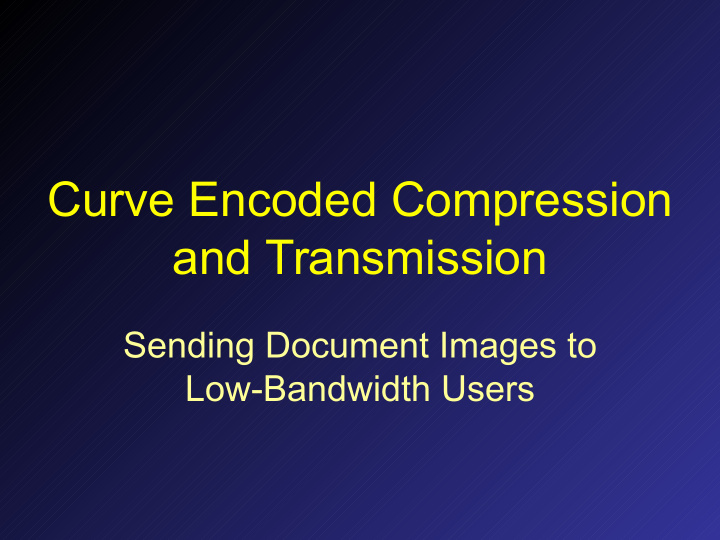



Curve Encoded Compression and Transmission Sending Document Images to Low-Bandwidth Users
Document Images Digital Libraries • Wide Distribution • Easy Access • Less “Shelf” Storage Digital Media • Text Transcripts • Document Images Genealogical Document Images • Handwriting (no OCR) • Mostly Bi-tonal (but needs grayscale) • “Browsing” Operations
Challenges Large File Sizes Slow Connection Speeds How do we give researchers the ability to browse through family history document images quickly despite “low bandwidth” connection speeds?
Approach One: Image Compression Transform “Hybrid” Strategies • JPEG • DjVu (Bottou et al. ‘98) • Wavelet • SLIm (http://research.microsoft.com/dpu/) • DigiPaper (Huttenlocher et al. ’00) Context • GIF • CCITT-G4 Codebook • JBIG2 • JB2 Background Image Foreground Mask
Approach Two: Progressive Transfer Content Progressive Quality Progressive Example: DjVu (Bottou et al. ‘98) Example: JITB (Kennard ’03)
Curve Encoded Compression and Transmission (CECAT) Compression 1) Extract Foreground Mask from Image 2) Detect and Mark the Contours 3) Encode Contours as 1 st – 3 rd Order Bezier Curves 4) Group Curves by Locality & Priority Transmission 1) Transfer & Fill Most Important Contours 2) Transfer Rest of Foreground 3) Add Grayscale Variations to Foreground 4) Transfer Background Color Image
Preprocessing: From Image to Contours 1) Convert to Grayscale 2) Apply Median Filter (Hutchison ’04) 3) Thresholding Operation (Niblack ’85) 4) Contour Detection (Witten et al. ’94)
Finding a Parametric Fit to Contours Curve Order Bezier Curve Parametric Representation File Size 1st (Line) p (u) = (1-u) p 0 + u p 1 4 bytes 2nd (Quadratic) p (u) = (1-u) 2 p 0 + 2u(1-u) p 1 + u 2 p 2 6 bytes 3rd (Cubic) p (u) = (1-u) 3 p 0 + 3u(1-u) 2 p 1 + 3u 2 (1-u) p 2 + u 3 p 3 8 bytes p (u) = points on the curve (u Є [0, 1]) p n = Bezier control points Results Using Least-Squares-Best-Fit Algorithm 122 Quadratics (max 732 bytes) 77 Quadratics & 59 Lines (max 698 bytes) 228 Lines = (max 912 bytes)
Lossy Compression: Error Tolerance Error Metric : Maximum 16.0 2.0 1.0 8.0 4.0 0.5 0.5 Pixel Distance Between Points on the Contour 1.0 and the Parametric Curve 2.0 4.0 8.0 16.0
Progressive Transfer: Foreground Encoding Strategy: Sort Parametric Curves According to Locality and/or Priority Transfer Strategy: Send (and Fill) the Most Important Sets of Contours First Demonstration
Progressive Transfer: Background 1) Foreground Mask Complete 2) Foreground Grayscale Data 3) Background Color Image
References DjVu – http://www.djvuzone.org/home.html DigiPaper – http://www.dlib.org/dlib/january00/moll/01moll.html Contour Following – Ian H. Witten et al. Managing Gigabytes . Van Nostrand Reinhold: New York. 1994 Niblack Thresholding – Wayne Niblack. An Introduction to Digital Image Processing . Prentice-Hall International, 1985. Just-In-Time-Browsing – Douglas J. Kennard. Just-In-Time Browsing for Digital Images . Thesis Presented to BYU: February 2003 Quadratic Contour Compression – Michael D. Smith. Handwriting Compression using Quadratic Curves . BYU CS 750 Project Write-Up. November 29, 2003 Median Filter Background Removal – Luke A. D. Hutchison et al. Fast Registration of Tabular Document Images Using Fourier-Mellin Transform . In Proceedings of DIAL04 , pages 253-269, January 2004.
Recommend
More recommend